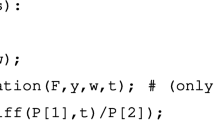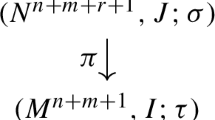Abstract
This paper is the applied counterpart to previous results [5] for linear-analytic control systems. It is mainly concerned with two canonical representations of the exponential type. They exhibit the Lie algebraic structure of the system in such a form that results on weak controllability are easily derived in an algebraic manner. The first representation is a single exponential of a canonical Lie series in Hall's basis of the Lie algebra of vector fields. The second one is a factorization in terms of simpler exponentials of Hall's basic vectors. Both of them exhibit, as canonical coefficients, an infinite set of characteristic parameters which are a minimal representation of the input paths, when no drift occurs in the system (or, equivalently, in the weak control case). The weak controllability theorem is easily derived from these results, in a purely algebraic way.
Similar content being viewed by others
References
N. Bourbaki,Groupes et Algèbres de Lie, Hermann, 1972, Chaps. 2 and 3.
K. T. Chen, Integration of paths. A faithful representation of paths by noncommutative formal power series,Trans. Amer. Math. Soc.,65 (1958), 163–178.
L. Comtet,Analyse Combinatoire, Vols. 1 and 2, Collection SUP, Presses Universitaires de France, 1970.
M. Fliess, Un outil algébrique: les séries formelles non commutatives, Rapport de Recherche I.R.I.A. No. 139, 1975.
M. Fliess, Fonctionnelles causales non-linéaires et indéterminées non-commutatives,Colloque IRIA on Méthodes Algébriques et Géométriques en Automatique Non-linéaire, 13–17 February 1978, IRIA Service Formation.
M. Fliess, M. Lamnabhi, and F. Lamnabhi-Lagarrigue, An algebraic approach to nonlinear functional equations,IEEE Trans. Circuits and Systems,29 (1983).
K. O. Friedrichs, Mathematical aspects of the quantum theory of fields, V,Comm. Pure Appl. Math.,6 (1953), 1–72.
F. R. Gantmacher,Matrix Theory, Vols. I and II, Chelsea, New York, 1960.
P. Hall, A contribution to the theory of groups of prime power order,Proc. London. Math. Soc. (2),36 (1933), 29–95.
G. W. Haynes and H. Hermes, Nonlinear controllability via Lie theory,SIAM J. Control Optim.,8 (1970), 450–460.
R. Hermann, On the accessibility problem in control theory, inNon-linear Differential Equations and Non-linear Mechanics (Proceedings of the International Symposium held on 31 July to 4 August, 1961), Academic Press, New York, 1963.
R. Hermann,Differential geometry and the calculus of variations, Inter-disciplinary Mathematics, vol. 17, Math. SCI Press, 1977.
R. Hermann and A. H. Krener, Non-linear controllability and observability,IEEE Trans. Automat. Control,22 (1977), 728–740.
T. Huillet, A. Monin, and G. Salut, Lie algebraic representation results for nonstationary evolution operators,Math. Systems Theory,19 (1987), 205–226.
C. Lobry, Controlabilité des systèmes non-linéaires,SIAM J. Control Optim.,8 (1970), 573–605.
W. Magnus, On the exponential solution of differential equations for a linear operator,Comm. Pure Appl. Math.,7 (1954), 649–673.
D. Perrin and G. Viennot, A note on shuffle algebras, Unpublished note, 1982.
R. Ree, Lie elements and an algebra associated with shuffles,Ann. of Math.,68 (1958), 210–220.
J. P. Serre,Lie Algebra and Lie Groups, Mathematical Lecture Note Series, Benjamin-Cummings, 1965.
H. J. Sussmann, A product expansion for the Chen series, inTheory and Applications of Non-Linear Control Systems (C. I. Byrnes and A. Lindquist, eds.), Elsevier, New York, 1986.
H. J. Sussmann, Semi-group representations, bilinear approximations of input-output maps, and generalized inputs, inMathematical Systems Theory (G. Marchesini and S. K. Mitter, eds.), Lecture Notes on Economics and Mathematical Systems, Vol. 131, Springer-Verlag, Berlin, pp. 172–191.
E. Witt, Treue Darstellung Lieschen Ringe,J. Grelle,177 (1937), 152–160.
Author information
Authors and Affiliations
Rights and permissions
About this article
Cite this article
Huillet, T., Monin, A. & Salut, G. Lie algebraic canonical representations in nonlinear control systems. Math. Systems Theory 20, 193–213 (1987). https://doi.org/10.1007/BF01692065
Received:
Revised:
Issue Date:
DOI: https://doi.org/10.1007/BF01692065




